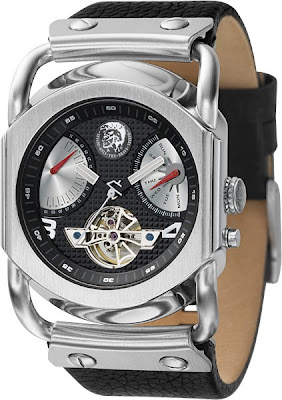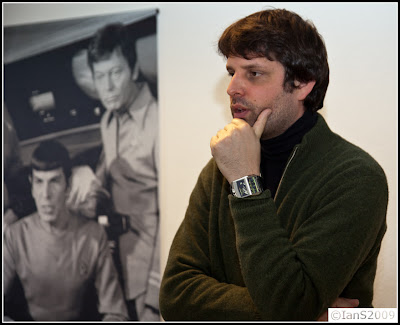 BEHOLD THE BEHEMOTH!
BEHOLD THE BEHEMOTH!Diesel, a brand that pushes envelopes, or rather sleeves with their constantly revolving motley crew of watches. Just introduced is the Super Bad Ass Collection. Above, the DZ7127 with laser blue crystal changing color from blue to yellow depending on the angle and FOUR separate timezones - one main chronograph, a digital display and two other analog clocks.
A watch that lets you keep tabs on the bedtimes of your illegitimate children around the globe. Comes in both Black DZ7125 and Brown DZ7126.
I had a Q&A with Wilbert Das, creative director of Diesel and asked him about the direction of Diesel Timeframes...
Watchismo: Why and When did Diesel start producing watches? How did that begin?
Das: Diesel launched the timeframe collection with Fossil in 1999 . Renzo Rosso, the founder of Diesel wanted to truly make Diesel a 360° lifestyle brand. Timeframes were the next step in making that a reality.

The other series of Badass watches are part of the Black Label Collection, the Three Time Zone with asymmetric case coming in the black dial steel bracelet (above) DZ9052 or brown Dz9053
Watchismo: Will Diesel continue to push the envelope with adventurous designs? Is it important to stand out in the watch world?
Das: Diesel will always push the envelope when it comes to the design. We like to make people stop and think about the product. Of course, we love it when we are featured in the watch world but what’s more important is that Diesel stick to the brand DNA and continue to keep things new for our customers.
 Also introduced are really adventurous new designs like the DZ9043 Hinged Triple Time Zone, the hardware allows for the watch to hug to the shape of your wrist and look good considering its massive size.
Also introduced are really adventurous new designs like the DZ9043 Hinged Triple Time Zone, the hardware allows for the watch to hug to the shape of your wrist and look good considering its massive size.
One of the more controversial models just announced is this (above) No Face watch DZ9044 & DZ9045 which at first glance looks to be a block of steel but is in fact, four separate watches located on the sides of the watch only (shown below). I would love to be a part of these brainstorming sessions at Diesel, they are obviously trying to challenge what a watch is and what it can be.
 And satiating my mechanical tastes, they are also producing some very beautiful skeletonized timepieces (watches with exposed movements). Up until recently, interesting mechanical watches were only for the rich but Diesel has introduced some really great designs with visible Automatic mechanics, rotors, balance wheels, the works!
And satiating my mechanical tastes, they are also producing some very beautiful skeletonized timepieces (watches with exposed movements). Up until recently, interesting mechanical watches were only for the rich but Diesel has introduced some really great designs with visible Automatic mechanics, rotors, balance wheels, the works!Watchismo: With mechanical timepieces being more and more popular, will Diesel keep developing new higher-end automatic watches?
Das: We'll definitely keep developing new higher-end automatic watches as we think it's the future!!!

Another remarkable mechanical watch is this Black Label DZ9017 Automatic Retrograde. The case is suspended on bars that penetrate all the way through the watch and the dial features two retrograde date displays (when they get to the bottom, they "jump back" instead of going in a full rotation) and an exposed balance wheel seen from the front and a rotor from the back. Really love how Diesel has been advancing their designs to reflect complexity in both mechanics and design!
 And making a huge impact with people recently, the Freak of Nature DZ4160 aka "Frankenwatch". People either love it or hate it, nothing in between. What appears to be a touched-up photo is the actual watch, a Frankenstein timepiece cross-breeding two entirely different watches into one. A hybrid wristwatch fusing a steel oval case with a gold square surrounding a split-faced multi-colored chronograph dial. Best of all, check out the half leather strap, half metal bracelet. There is a tamer version too, the DZ4159.
And making a huge impact with people recently, the Freak of Nature DZ4160 aka "Frankenwatch". People either love it or hate it, nothing in between. What appears to be a touched-up photo is the actual watch, a Frankenstein timepiece cross-breeding two entirely different watches into one. A hybrid wristwatch fusing a steel oval case with a gold square surrounding a split-faced multi-colored chronograph dial. Best of all, check out the half leather strap, half metal bracelet. There is a tamer version too, the DZ4159.Watchismo: What are some of the likely directions in the future for Diesel watches?
Das: Diesel generally seeks a point of difference and wants to keep an edgy feel to their products. Thanks to the collaboration between Diesel and Fossil we want to keep on offering our consumer a solid know-how and a very creative touch, keeping on developing and introducing outstanding watches.

Ok, this is my favorite of the bunch, the DZ1242 Sonar Seconds Triple Time Zone. I don't believe it comes across in the photo but this is the Godzilla of the bunch. You don't wear this watch, IT WEARS YOU! Shot a little video of the radar style seconds in action below.
 Anyone that knows me knows I have a tremendous nostalgia for the sideview LED watches of the seventies, models like the Bulova Computron, Mido Swissonic, Girard Perregaux Casquette, Synchronar and others. So obviously I must feature the DZ7091 with it's steroidal nod to that era of vintage digital LED timepieces.
Anyone that knows me knows I have a tremendous nostalgia for the sideview LED watches of the seventies, models like the Bulova Computron, Mido Swissonic, Girard Perregaux Casquette, Synchronar and others. So obviously I must feature the DZ7091 with it's steroidal nod to that era of vintage digital LED timepieces.Watchismo: Diesel watches have always a spirit of both vintage and modern looks, what are the sources of inspiration for all the designs, especially the Black Label collection and the watches with side time-zones, hinges and see-thru dials.
Das: Diesel is a unique brand that attracts people that are creative and have the same sensibilities. Diesel takes that idea and incorporates it into all aspects of the brand. We’re a global company and our customers are as well, hence the time zones on our watches. Vintage is also really important to our consumers, especially in the denim world which translates into their lifestyle.
Shop for Diesel Watches









































